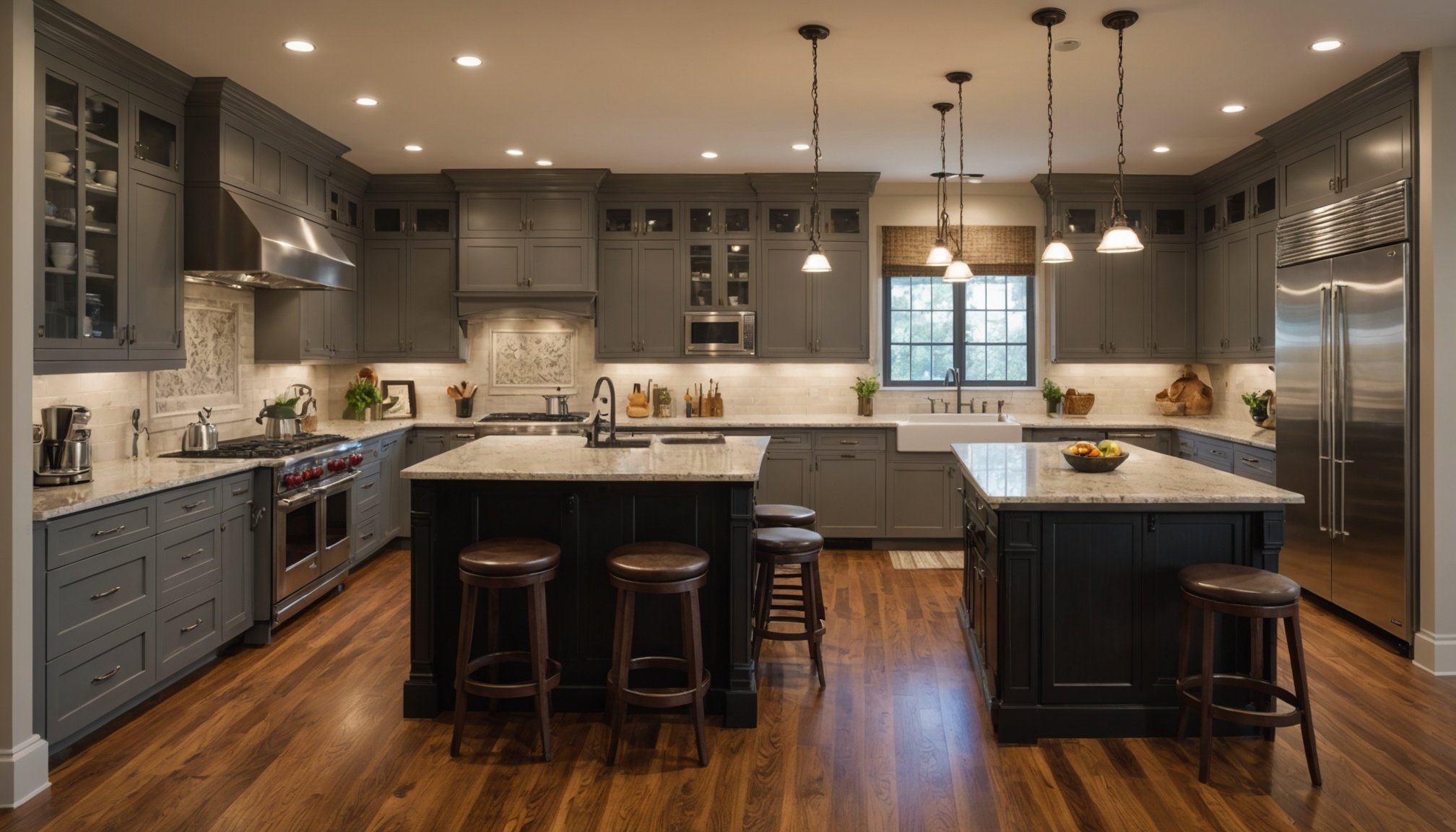Understanding Adjustable Track Lighting
Adjustable track lighting is a dynamic solution for kitchen lighting design, offering flexibility and style. Unlike traditional fixed-position lighting, adjustable track lighting systems allow homeowners to direct light to specific areas, enhancing the functional and aesthetic aspects of a kitchen. This modern approach includes an array of lighting fixtures that can be customized to fit varying kitchen design styles, ensuring that it complements both contemporary and classic decors.
In a kitchen environment, track lighting proves advantageous due to its versatility. It can be adjusted to highlight particular spots, like cooking areas or countertops, making food preparation easier and safer. Additionally, its sleek design often contributes to the overall kitchen lighting design, removing the need for multiple bulky fixtures and enabling a tidy and uncluttered ceiling appearance.
Also to see : Streamline Your Slim Diet: Revolutionize Your Kitchen with a Meal Planning Whiteboard
When comparing track lighting with traditional lighting options, several benefits emerge. Adjustable track lighting offers the ability to tailor lighting angles and intensities, enhancing both task and ambient lighting. Furthermore, its installation is generally less invasive, as it usually doesn’t require extensive electrical rewiring, making it a practical choice for renovations and new kitchens alike. This combination of flexibility, efficiency, and ease positions adjustable track lighting as an optimal choice for modern kitchens.
The Aesthetic Influence of Lighting on Meal Presentation
Understanding how meal presentation benefits from careful lighting considerations can significantly enhance the dining experience. Specifically, the impact of appropriate lighting on food aesthetics involves several aspects, primarily focusing on lighting effects.
In parallel : Transform Your Kitchen: Discover the Advantages of a Vertical Spice Rack for Effortless Access to Metabolism-Enhancing Spices
Role of Lighting in Highlighting Flavors
Lighting plays a subtle but vital role in food aesthetics, enhancing flavours visually through its interaction with food. For instance, warm lighting can highlight the golden hues of roasted dishes, making them more appetising. The angle of light can cast shadows that accentuate textures, bringing out intricate details of the dish.
Impact on Color Perception
Different lighting temperatures can alter the appearance of colour in food. Cooler lighting might make greens appear more vibrant, while warmer tones can enrich reds. This alteration can change diners’ perception, making meals more attractive, and emphasising the lighting effects.
Creating Depth and Texture
The interplay between light and shadow adds depth, creating a rich texture. By strategically placing lights, you can enhance the outline and surface of food, contributing to a more dynamic presentation. Optimal use of these lighting effects can elevate the entire dining atmosphere, making meals visually pleasing.
Adjustable Track Lighting and Portion Sizes
Lighting plays a fascinating role in altering the perceived size of food portions, which can significantly impact the dining experience. Research has shown that the choice of lighting can influence visual cues that affect portion size perception.
Lighting conditions are indeed linked to eating behaviours. Studies suggest that bright lighting can make meals appear larger, encouraging diners to eat less. Conversely, dim lighting might make portions seem smaller, resulting in increased consumption. These lighting effects can subtly control portion sizes, fostering better eating habits.
To leverage lighting for portion control, consider these practical strategies:
- Incorporate adjustable track lighting to tailor the intensity based on the time of day or type of meal.
- Use cooler lighting to enhance the appearance of green and vibrant dishes, providing a sense of bountifulness.
- Ensure that the lighting highlights the meal’s centerpiece to focus diners’ attention, thereby regulating their eating behaviour.
Innovative track lighting can thus serve not only as an aesthetic tool but also as a functional element influencing portion perception, complementing the overall kitchen lighting design.
Practical Tips for Implementing Adjustable Track Lighting
Integrating adjustable track lighting into your kitchen design adds both functionality and style. Here’s how to make the most of this innovative lighting option.
Choosing the Right Fixtures
Consider the overall kitchen design. Select lighting fixtures that not only complement your decor but also provide sufficient light for task and ambient lighting. Opt for fixtures that allow easy adjustment of the lighting direction and intensity to accommodate different culinary scenarios.
Strategic Placement for Optimal Effects
Proper lighting placement is crucial. Position track lights to highlight work areas, such as countertops and kitchen islands, where task lighting is essential. Aim the lights to minimize shadow in critical zones, enhancing both visibility and aesthetic appeal.
Adjusting Brightness for Different Scenarios
Tailor the brightness to suit various kitchen activities. Bright, focused light is ideal for meal preparation, while softer lighting creates a relaxed atmosphere for dining. Adjustable settings on modern track lighting systems offer the flexibility to easily transition between different levels of brightness, adapting to your needs.
Implementing these practical tips will ensure your kitchen lighting design is not only beautiful but also highly functional, enhancing the overall cooking and dining experience.
Before-and-After: Transforming Your Kitchen with Lighting
Using adjustable track lighting in a kitchen makeover can drastically alter both its aesthetics and functionality. Homeowners can achieve a significant design transformation by opting for customizable lighting fixtures that cater to various styles, whether contemporary or traditional. These adjustments create a visually appealing and practical kitchen environment, enhancing meal preparation and presentation.
Visual case studies vividly illustrate the impact of new lighting installations. Before-and-after images often show stark contrasts in how kitchens look and feel. For instance, brighter track lighting can highlight architectural details and emphasize textures on surfaces like countertops, making the overall space feel more inviting. These transformations not only enhance the visual beauty of the kitchen but also contribute to a more cohesive kitchen lighting design.
User testimonials frequently highlight positive changes in both dining habits and ambiance following lighting upgrades. Many people notice a heightened enjoyment in meal preparation and consumption due to improved visibility and enhanced food aesthetics. The right lighting can make the kitchen a more engaging space, encouraging healthier eating habits by subtly influencing portion perception. Thus, adjustable track lighting stands as a transformative tool in modern kitchen design.
The Relationship Between Lighting, Environment, and Enjoyment
Creating the perfect dining ambiance is a delicate balance of lighting, environment, and enjoyment. Lighting holds power in enhancing social interactions. For instance, soft, warm lighting often fosters intimate conversations, signalling relaxation and comfort. In contrast, bright, overhead lights can energize and invigorate, ideally suited for more festive gatherings.
Lighting’s Role in Enhancing Social Interactions
Imagine a dinner setting with subtle, dim lights casting a gentle glow across the table. This scenario encourages people to linger, enjoying each other’s company and generating a sense of connection. It’s these lighting choices that create an inviting atmosphere, making guests feel at ease.
Creating an Inviting Atmosphere
The lighting’s impact extends beyond just the social aspect; it crucially affects the psychological experience. A well-thought-out lighting setup can boost dining satisfaction by engaging the senses. For example, tailored lighting arrangements can illuminate the table’s setting, highlighting culinary efforts in a sensory experience that elevates overall enjoyment.
The psychological effects of lighting can profoundly influence dining, from mood enhancement in intimate settings to fostering lively discussions in brighter environments. Effective lighting transforms not only kitchens but also dining experiences, ensuring guests leave with memorable impressions.

